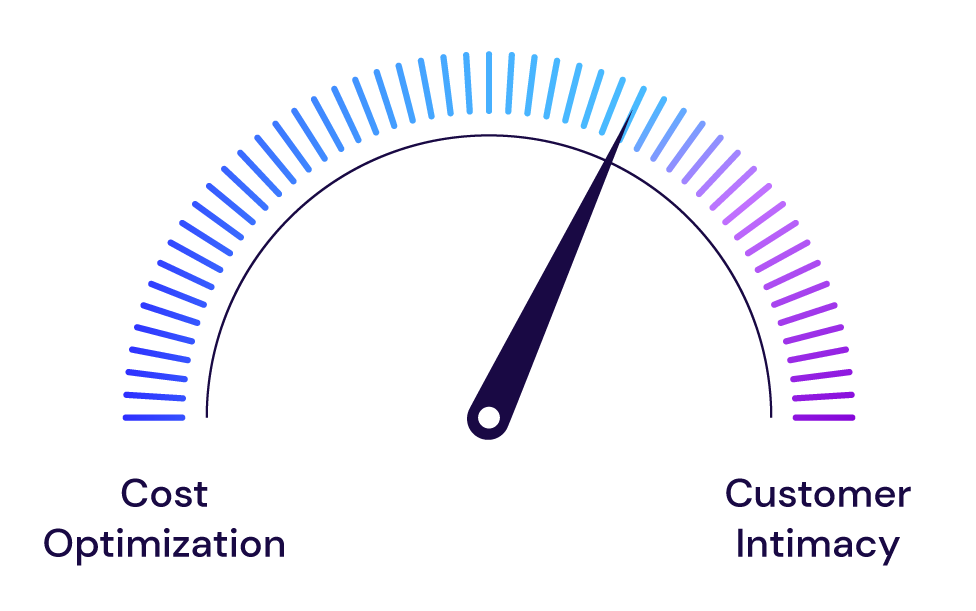Resolving the Customer Experience paradox
My experience in the world of Customer Experience over the last 25 years
by: Ronald Rubens

Today are both exciting and alarming times in the world of customer experience. Over the last 25 years, I have seen how new technologies can create extra-ordinary experiences for customers and organizations. However, the reality on the ground is often different as organizations in their quest for optimizing operational efficiency, have applied a variety of technologies, such as bots, to take over where skilled people and knowledge workers once excelled. These bots turned out to be effective by successfully managing customer interactions, but also created friction or revenue loss when customers expected immediate access to a live agent. The good news is that I believe this old-age paradox of customer excellence versus operational efficiency is finally behind us; if organizations are doing the right things, they can now create extra-ordinary experiences while benefiting from operational efficiencies. However, before we get to the answer on how to achieve this, let’s have a look at some current facts and allow me to take you back in history.
It was only the other day that I had to wait for more than 24 hours to get an answer from a major airline on an urgent WhatsApp request, impacting an important customer visit. The next day I had to contact my energy company to renew a contract, but could not find the energy company’s phone number on their website. Given the recent developments on energy, the energy company took the decision to hide their customer service phone numbers with the hope that most interactions could now be taken over by a bot. And speaking about bots, who has not recently interacted with a bot to find out that the bot didn’t understand our question or was not able to transfer us to an agent? Or when the bot finally agreed to transfer us to an agent, we had to repeat the information all over again or found out that the customer service agent was not the right person to help us out.
It seems that I was not alone in these challenges. Hold-times in call center queues have increased by more than 50% over the last two years. Despite attempts to reduce hold-times by using self-service capabilities, such as ‘interactive voice response’ and bots, 59% of all consumers feel companies have lost touch with the human element of customer experience. In a recent survey by Zendesk, 54% of respondents say it takes too many questions for the bot to recognize it can’t answer the issue and then they must start all over with a human agent. As a result of these recent experiences 61% of customers would now defect to a competitor after just one bad experience as expectations around customer experience have risen in the digital age. So, what can we learn from history?
At the turn of the century, I worked in the United States with a talented group of Bell Labs Engineers in the contact center division of what is now called Avaya. My manager at the time gave me a book titled: “The Discipline of Market Leaders” by Treacy and Wiersema. It was one of these New York Time best sellers, which instantly became a success as it described three paths to market leadership. These three paths – also known as value disciplines – were customer intimacy, operational excellence, and product leadership. In essence, a company had to pick one of these disciplines while meeting industry standards in the other two. To become ‘Masters of two’ of these disciplines was a real challenge as inherent tensions would appear between the operating models that each value discipline demanded. In the contact center and customer experience space, this led to a so-called customer experience paradox as customer intimacy and operational efficiency were hard to unite under a single all-encompassing value discipline. Companies had to deal with trade-offs between the quality of the customer experience and the costs of providing it. This trade-off always seemed baffling to me, and a life-long quest started to explore how we could break this paradox and to bring both customer intimacy and operational excellence in balance.

Twenty years later, encouraged and inspired with the famous words of Steve Jobs: “You’ve got to start with the customer experience and work your way backwards to the technology”, I started a discovery of the fundamental issues in the customer experience space and founded what is now SentioCX. “Sentio” is a Latin word for “I experience” or “I feel” to emphasize the starting point of customer experience. Our vision was to find a way to have technology – in this case bots – and humans work together seamlessly, to create extra-ordinary and frictionless experiences for the customer and as a result create an optimum between operational efficiency and customer intimacy. Today, we believe that we are finally able to unite these two paradoxical disciplines.
Our vision at SentioCX was to have companies, who were using bots and conversational AI technology, benefit from cost savings while at the same time improving customer retention and satisfaction by providing a seamless transfer from a bot to a live agent. It seemed simple and straightforward as I write this, but the challenges to make this happen were multiple. How do we make it seamless for customers? How can we ensure that questions from customers get solved the first-time? When is the right moment for the bot to hand-off the call to a live agent – in some cases pro-actively? How do we make sure the most qualified agent gets a specific call? The proliferation of Artificial Intelligence and a variety of omni channel concepts brought many powerful use-cases for Contact-Center-as-a-Service and Conversational AI technology, except providing a seamless transfer from a bot to a live agent. At best, agent hand-offs from a bot were ‘blind transfers’ by throwing a ball over the fence or launching chats in agent queues with the hope that the agents would pick out the most relevant chats. So, what was the answer?

Along with deep integration with bots, conversational AI applications, service management and live chat applications, we discovered very early on that we needed ‘a routing algorithm’. After doing extensive research of ACD (Automatic Call Distribution) routing algorithms known today in the contact center and CCaaS (Contact-Center-as-a-Service) space, we discovered that most routing algorithms were too basic in the sense that they could only route chats or voice calls based on historical importance of the customer (retrieved from a CRM system) or IVR (Interactive Voice Response) choices. Hence, we couldn’t use these existing algorithms to facilitate a seamless hand-off to an agent.
The customer experience we wanted to provide was that by applying Artificial Intelligence, the bot would understand the customer and more importantly, detects ‘early on’ that it doesn’t understand the customer or believes that human intervention is required. It would then pro-actively with priority and/or urgency seamlessly hand-off the chat to the right agent with the right skills and proficiency levels or if necessary to a knowledge worker with a specialized skill.
What we wanted to accomplish was apart from the customer profile, to classify and prioritize real time intents captured by the bot and based on these intents match the chat with an agent or knowledge worker with the relevant skills and proficiency levels and dynamically adjust the routing priority. So, what we did was to start inventing a ‘brand new approach’ of a sophisticated ACD (Automatic Call Distribution), which we now refer to as our ‘Intent-based Intelligent Routing engine’. And so it began: we filed a patent, simulated the algorithm, validated it, and started to build the product by hiring a bunch of talented software engineers who were as passionate about this business as we were.
During the time of Tracey and Wiersema’s publication of their book, customer experience managers had a challenging job: they had to choose between operational efficiency and customer experience. Today we believe that with the advent of technology, and our work at SentioCX, we are now able to unite these two paradoxical disciplines. I am excited about the future. Not only for our company and the difference we are making, but also for the future of the CX industry and the end-customer. I believe that with the right actions, we can create a perfect symbiose of technology, bots, call center agents and knowledge workers, working to create great experiences for customers and organizations.